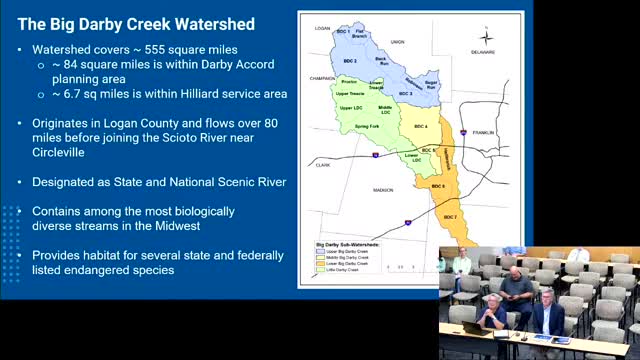City implements ambitious plan to protect open spaces
September 13, 2024 | Hilliard, Franklin County, Ohio
This article was created by AI summarizing key points discussed. AI makes mistakes, so for full details and context, please refer to the video of the full meeting. Please report any errors so we can fix them. Report an error »

In a recent government meeting, officials highlighted significant advancements in environmental protection and urban development within the Big Darby region. The discussions centered on the implementation of regulations aimed at safeguarding the National Scenic River and its diverse ecosystems.
Key initiatives include the preservation of open spaces and the introduction of density bonuses for developments that incorporate stream restoration efforts. Recent zoning changes have increased open space requirements for residential developments to 70%, while the newly adopted Conservation Employment Zoning District mandates a 60% open space standard, surpassing the previous 50% benchmark.
The city has invested nearly $3.5 million in stream restoration projects, particularly in the Hamilton and Clover Groff areas, transforming traditional farm ditches into more natural serpentine flow patterns. These efforts are part of a broader Community Plan Update that envisions a green belt on the western side of Hilliard, connected by a network of trails to enhance community access to nature.
To date, almost 500 acres of open space have been conserved in the Derby region, primarily through development-related requirements. The Active Transportation Thoroughfare Plan outlines future trails that will link these open spaces, promoting connectivity and environmental appreciation among residents.
Officials also addressed sanitary sewer limitations imposed by the City of Columbus, which could impact future development standards. The meeting underscored the community's commitment to balancing growth with environmental stewardship, setting a precedent for sustainable urban planning in the region.
Key initiatives include the preservation of open spaces and the introduction of density bonuses for developments that incorporate stream restoration efforts. Recent zoning changes have increased open space requirements for residential developments to 70%, while the newly adopted Conservation Employment Zoning District mandates a 60% open space standard, surpassing the previous 50% benchmark.
The city has invested nearly $3.5 million in stream restoration projects, particularly in the Hamilton and Clover Groff areas, transforming traditional farm ditches into more natural serpentine flow patterns. These efforts are part of a broader Community Plan Update that envisions a green belt on the western side of Hilliard, connected by a network of trails to enhance community access to nature.
To date, almost 500 acres of open space have been conserved in the Derby region, primarily through development-related requirements. The Active Transportation Thoroughfare Plan outlines future trails that will link these open spaces, promoting connectivity and environmental appreciation among residents.
Officials also addressed sanitary sewer limitations imposed by the City of Columbus, which could impact future development standards. The meeting underscored the community's commitment to balancing growth with environmental stewardship, setting a precedent for sustainable urban planning in the region.
View full meeting
This article is based on a recent meeting—watch the full video and explore the complete transcript for deeper insights into the discussion.
View full meeting
